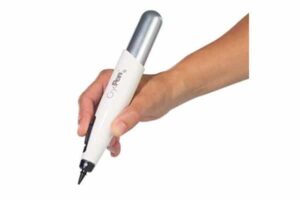What Is Cryotherapy?
Cryotherapy is used to treat a wide range of benign skin lesions using extreme cold. It’s known for being precise, quick, and nearly pain-free, making it a popular choice in medical practices and aesthetic clinics.
Unlike older cryotherapy methods (which used cotton buds and liquid nitrogen in an open spray), new techniques offer pen-like precision, making it much safer for use on the face, delicate skin or around the eyes.

How Does Cryotherapy Work?
Cryotherapy uses pressurised nitrous oxide (N₂O) at very low temperatures to freeze and destroy abnormal or unwanted skin cells.
Here’s a simple breakdown of the process:
- Targeting the lesion – The practitioner points the cryotherapy device directly at the lesion.
- Freezing – A super-cooled jet of nitrous oxide is applied, freezing the tissue in seconds.
- Cell destruction – The intense cold causes ice crystals to form inside the cells, disrupting the cell structure and leading to the destruction of the lesion.
- Natural healing – The treated area may blister or crust, then naturally falls away over 1–2 weeks, revealing new, healthy skin underneath.
What Can Cryotherapy Remove?
Cryotherapy is designed to remove benign (non-cancerous) skin lesions. It’s important that any lesion is properly diagnosed before treatment to rule out anything suspicious.
Common conditions treated with Cryotherapy include:
- ✅ Skin tags
- ✅ Warts (including plantar warts on the feet)
- ✅ Seborrheic keratoses (age warts)
- ✅ Sun spots / solar lentigines (sun damage or liver spots)
- ✅ Cherry angiomas (red blood vessel spots)
- ✅ Milia (tiny white bumps)
- ✅ Viral verrucae
- ✅ Pigmentation spots
❗ Note: Cryotherapy is not suitable for suspicious moles, melanomas, or cancerous lesions. These must be reviewed by a medical professional.
What to Expect During and After Treatment
During treatment:
- Most people feel a mild stinging or cold sensation during the freeze, similar to a quick pinprick.
- No anaesthetic is needed.
- Sessions usually last less than 60 seconds per lesion.
After treatment:
- The area may become red, swollen, or blistered.
- A scab may form and fall off naturally within 7–14 days.
- Minimal to no scarring if proper aftercare is followed.
- It’s important to avoid picking at the area or exposing it to strong sun.
Benefits of Cryotherapy
- ✅ Non-invasive – No cutting or stitches required.
- ✅ No downtime – Most people can resume normal activities immediately.
- ✅ Precision – Targets only the lesion, sparing healthy surrounding skin.
- ✅ Quick results – Often visible improvement within days.
- ✅ Minimal discomfort – No anaesthetic required.
- ✅ Safe for most skin types (though darker skin tones should discuss pigment risks with a provider).
Is Cryotherapy Right for You?
Cryotherapy is ideal if you’re looking for a fast, effective, and low-risk way to remove benign skin lesions — especially if they’re in a visible or sensitive area.
However, always make sure your skin concern is assessed by a qualified professional before treatment. Some spots that look harmless can actually be more serious.
Final Thoughts
Cryotherapy offers safe, targeted treatment for a variety of everyday skin concerns. Whether it’s a cosmetic issue like a skin tag or a stubborn wart you’ve tried everything on, Cryotherapy might be the simple solution you’ve been looking for.

